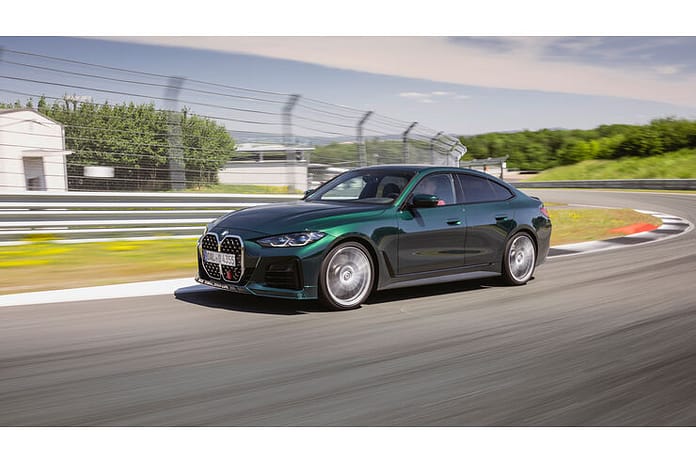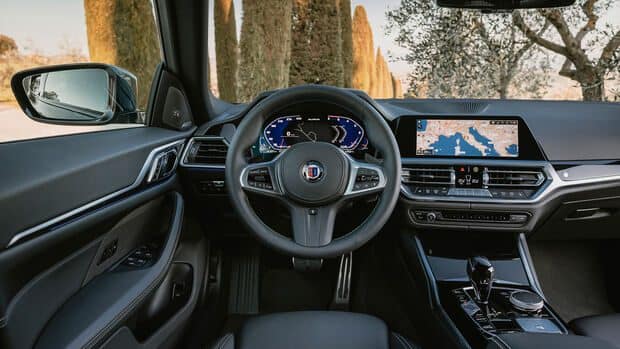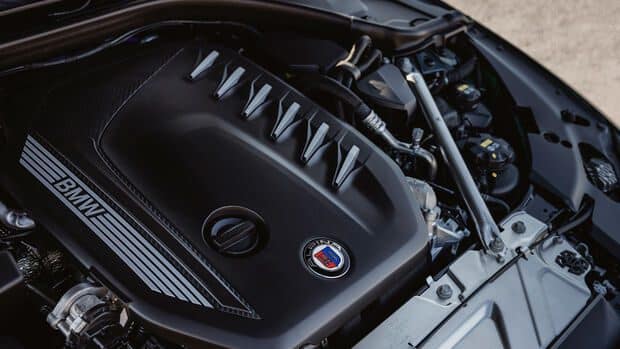BMW Alpina is no longer producing the B4 and D4 as a coupe and convertible, but for the first time as a Gran Coupé. In order not to get bored, they head straight to the challenging Bilster Berg test circuit.
In the history of the company, dating back to 1965, Alpina has always managed to find gaps in the BMW model range, in order to usually fill them optimally – and, hello, the B4 and D4 S are presented in the photo. coupe? As convertible? No, this place now seems too small. Alternatively: Gran Coupé. How does it fit into your model range? In other words: How is it different from the B3 and the D3 S? While the B4’s long bonnet extends under load over the sections of Fledermaus Hügel, Pumpenhaus, Munitionsfeld and Jägerbuche in the direction of the Driburger Lichtung, it barely starts at first.
Roman Ritzky
The cockpit of the new BMW Alpina D4.
The six-cylinder, twin-charged petrol engine (Mono Scroll) does not seem to be particularly incompatible with the four-door car, which weighs 1,965 kilograms according to the manufacturer, turns effortlessly and with a deep, hoarse voice at 7000 rpm. The engine, which is based on the BMW S58 engine, develops 495 hp and generates a maximum torque of 730 Nm at 2500 rpm, which should be enough to accelerate the quad from a stationary start to 100 km / h in 3.7 seconds and in 12, 9 seconds For acceleration to 200 km / h.
Out of the box
In any case, the sometimes large terrain of the demanding test track Bilster Berg isn’t much of a challenge, and the response is more spontaneous than the torque values per minute might suggest. The Alpina uses its own turbocharger housing and improved cooling and airflow, on the intake and exhaust sides. The ZF’s eight-speed automatic transmission is tuned to match torque, and shifts under load with a noticeable jolt, but without delay on paddle commands, on a very comfortable D, on an overactive S at times. Alpina engineers also modified the control of the X-Drive all-wheel drive system. There is also a mechanical differential lock on the rear axle. So how does B4 turn out? Accurate and quiet, always agile, always on fire, although the body rolls and shakes noticeably under such heavy loads, despite the sporty chassis with adaptive dampers (negative camber 1.25 degrees on the front axle).
ambush curve
As usual at Alpina, B4 handling and reactions remain predictable and can be handled cleanly with the help of powerful feedback guidance. Even alternative, malignant curves such as the Clubhaus-S or the former’s telegraph bracket and commander’s desk combination allow the BMW Alpina’s 4.79-meter-long, custom-designed suit to glide – standard sport seats with limited lateral support under these conditions are the limiting factor.
Roman Ritzky
Little tendency to exaggerate? Not a problem.
What about self-directed behavior? Essentially neutral to slightly under-steered, only in response to load changes or ground use of gas it registers a little more rear. Just a little bit? Yes, because instead of 265 rear tires like the B3, the B4 uses 285 seconds, and the front stays at 255 seconds — all in 20 inches. By the way: Alpina only specs 12kg per piece for forged wheels.
Defeather right?
In any case, the Gran Coupé should be geared more towards touring travel, and, according to Albina, the cushioning of the transverse joints and asphalt stains is now much better than the B3, after all, the company’s customers like to cover 50,000 kilometers. A year with their car – yes, even with a gasoline engine. However, the extra comfort cannot be taken out today, since test cars may only be transported on a closed road. Well, it doesn’t matter, because: it’s fun. This engine alone! Inside, on the other hand: So far, a very large chainring – apart from charming Alpina folklore such as the plate with the serial number and, above all, the very soft leather of the steering wheel.
bi-mass society
And now: diesel. First, the bad news: the D4 S weighs 55 kg more than the B4, and the loads on the front axle. The six-cylinder twin-turbo engine also generates a maximum torque of 730 Nm, which is already available at 1750 rpm. Performance, however, is 355 hp. After B4 fireworks, does it look more like tea light? Not really, because the chassis tuning elegantly hides the extra weight, only occasionally revealing a tendency to understeer a little earlier.
Roman Ritzky
The BMW Alpina D4 engine produces 355 hp.
And even with the D4 S, one of them can certainly be afraid on the racetrack, because the diesel is also distinguished by a high level of reliability in handling. dent? Unintentional, even if the brake pedal shift initially seems a little longer than it does on the B4. However, it can also be due to unconditioned rubber. Anyway, you’re scanning through Mausefalle on your own, completely unconcerned, which is a curving mix through the valley with and then sky-driving based on Corckscrew in Laguna Seca, whose gravel bed likes to jump in in front of the car here. On the D4 S too, you bend slightly on all fours, get stuck in the hole, and push yourself up with torque. But a touring car in disguise? No way. But it’s a very fast touring car (0-100 km/h in 4.8 seconds, 0-200 km/h in 19.1 seconds) with very ambitious handling talent – and a WLTP consumption of 6.9 l/100 km (B4: 10.1 l/100 km). The same goes for the B4 and the D4 S: bridge the gap smartly.
opinion poll
Read more
conclusion
The good news: The B4 and D4 S continue the Alpina’s tradition of impressing with well-defined handling that’s extremely agile and equally safe. In the case of the B4, the driving pleasure with an intense petrol engine adorns feelings, while the diesel impresses above all with its carelessness and extreme efficiency (at least on paper). The bad news: After Monday, there probably won’t be any more newly developed Buchloe models. But this is another story.




